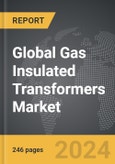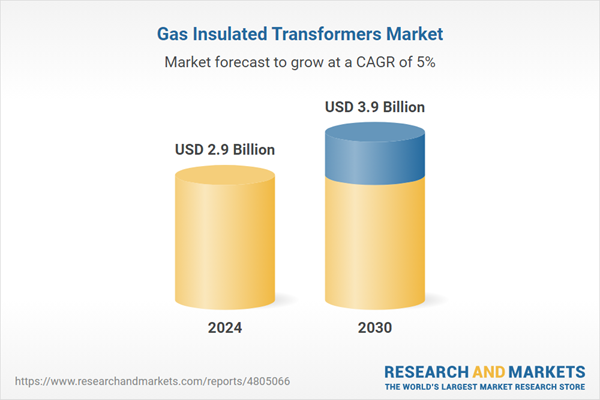Global Gas Insulated Transformers Market - Key Trends and Drivers Summarized
Why Are Gas Insulated Transformers Crucial in Modern Electrical Grids?
Gas insulated transformers (GITs) have become indispensable in today's electrical infrastructure due to their compact design, efficiency, and environmental benefits. But what makes them so essential in modern power grids? Unlike conventional oil-filled transformers, gas insulated transformers use sulfur hexafluoride (SF6), a highly effective insulating gas, to provide insulation and cooling for high-voltage systems. This allows them to be significantly more compact, making them ideal for urban environments and areas where space is at a premium. In large cities, where real estate is scarce, GITs can be installed indoors, underground, or in enclosed areas without posing significant fire or safety hazards. Moreover, their sealed, enclosed design makes them more resistant to environmental factors like moisture, pollution, and extreme weather conditions, ensuring a longer operational life and less maintenance.Gas insulated transformers are also critical in industries like renewable energy, where space and environmental impact are important considerations. They are used to step up or step down voltage in solar power plants, wind farms, and other renewable energy applications, contributing to more efficient power distribution. Additionally, with global energy demand rising and the need for reliable, uninterrupted power becoming more urgent, GITs provide the stability and reliability that modern electrical grids require. As grids become more complex and decentralized, gas insulated transformers offer the durability, space-saving benefits, and safety that make them an essential component of future power systems.
How Is Technology Enhancing the Performance of Gas Insulated Transformers?
Technological advancements are pushing the boundaries of gas insulated transformer design, making them more efficient, safer, and environmentally friendly. One of the most significant innovations is in the materials used for insulation and design. While SF6 gas has been the standard insulating medium due to its high dielectric strength and stability, researchers are developing alternative gases and gas mixtures that are less harmful to the environment. SF6 has a high global warming potential, and the industry is moving toward adopting more sustainable alternatives, such as fluoronitrile-based gases, that offer similar insulation properties but with a significantly lower environmental impact.Additionally, the integration of smart monitoring systems is transforming how GITs are operated and maintained. These systems use sensors and real-time data analytics to monitor transformer conditions like temperature, gas pressure, and insulation integrity. Predictive maintenance algorithms can then analyze this data to detect potential issues before they lead to costly failures or downtime. Remote monitoring capabilities also mean that operators can track transformer performance and make adjustments without being physically present, which is particularly useful in hard-to-reach or hazardous locations. Another advancement is the improvement in cooling systems. New cooling technologies allow for better heat dissipation, improving the efficiency of the transformers and extending their lifespan. These advancements in insulation materials, real-time monitoring, and cooling systems are not only improving the performance and reliability of gas insulated transformers but are also reducing their environmental footprint.
Why Are Sustainability and Space Efficiency Driving the Demand for Gas Insulated Transformers?
As the world shifts toward more sustainable practices, gas insulated transformers are emerging as a key technology for reducing the environmental impact of power infrastructure. One of the primary reasons GITs are becoming more popular is their ability to minimize space requirements while maximizing power output. In densely populated urban areas and regions where land is limited, traditional transformers that require large open spaces and cooling systems filled with oil are not feasible. GITs, with their compact design, can be installed in smaller spaces, underground, or even inside buildings, making them ideal for cities and industrial environments with limited real estate. This space efficiency is particularly valuable in growing urban areas, where the demand for electricity is high, but available land for electrical infrastructure is scarce.In terms of sustainability, GITs have an edge over their oil-insulated counterparts due to the lower risk of fire hazards and environmental contamination. Oil-filled transformers can leak or spill, causing soil and water contamination, whereas gas insulated transformers are sealed units with a lower likelihood of leakage or environmental damage. Additionally, advancements in gas technology are driving efforts to reduce or eliminate the use of SF6, a potent greenhouse gas. New insulating gases that have a much lower environmental impact are being researched and developed, positioning GITs as a more eco-friendly option for high-voltage power systems. As sustainability becomes a more pressing global priority, industries and governments are increasingly adopting gas insulated transformers to meet energy needs while minimizing their environmental footprint and maximizing space efficiency.
What Factors Are Fueling the Growth of the Gas Insulated Transformer Market?
The growth in the gas insulated transformer market is driven by several key factors, including urbanization, technological advancements, and a global push toward cleaner energy solutions. First, the rapid urbanization and expansion of cities are creating a need for compact and reliable power infrastructure. Gas insulated transformers are becoming the preferred choice for urban and densely populated areas, as they require far less space than conventional transformers and can be installed in locations with space constraints, such as underground or within buildings. This trend is particularly prominent in regions like Asia-Pacific and Europe, where space is limited but the demand for high-voltage power distribution is increasing.Second, advancements in insulation technology and gas alternatives are helping the market grow. As the industry moves away from SF6 due to its high global warming potential, alternative gases are being developed that offer similar insulating properties without the environmental drawbacks. These new gases, coupled with more efficient cooling and insulation systems, are driving innovation in the sector and making gas insulated transformers more attractive to environmentally conscious industries and governments.
Third, the shift toward renewable energy is boosting demand for gas insulated transformers, particularly in wind farms, solar power plants, and other renewable energy installations. These transformers play a crucial role in efficiently stepping up or stepping down voltage for distribution to the grid, making them essential for the renewable energy sector. As more countries commit to decarbonizing their power grids and increasing their renewable energy capacity, the demand for GITs is expected to rise.
Lastly, the need for resilient and reliable power systems is becoming increasingly important as extreme weather events and power outages become more common. Gas insulated transformers offer better protection against environmental factors like moisture, pollution, and extreme temperatures, making them a preferred option in regions prone to harsh weather conditions. These factors, combined with rising investments in power infrastructure and smart grid technologies, are driving the growth of the gas insulated transformer market, positioning it as a vital component of modern electrical systems and the energy transition.
Report Scope
The report analyzes the Gas Insulated Transformers market, presented in terms of market value (USD). The analysis covers the key segments and geographic regions outlined below.- Segments: Voltage (Below 72.5 kV, 72.5 - 220 kV, Above 220 kV); Type (Instrument Transformer, Other Types); End-Use (Utility, Industrial, Commercial).
- Geographic Regions/Countries: World; United States; Canada; Japan; China; Europe (France; Germany; Italy; United Kingdom; Spain; Russia; and Rest of Europe); Asia-Pacific (Australia; India; South Korea; and Rest of Asia-Pacific); Latin America (Argentina; Brazil; Mexico; and Rest of Latin America); Middle East (Iran; Israel; Saudi Arabia; United Arab Emirates; and Rest of Middle East); and Africa.
Key Insights:
- Market Growth: Understand the significant growth trajectory of the Instrument Transformer segment, which is expected to reach US$3.1 Billion by 2030 with a CAGR of 5.2%. The Other Types segment is also set to grow at 4.6% CAGR over the analysis period.
- Regional Analysis: Gain insights into the U.S. market, valued at $749.2 Million in 2024, and China, forecasted to grow at an impressive 7.7% CAGR to reach $865 Million by 2030. Discover growth trends in other key regions, including Japan, Canada, Germany, and the Asia-Pacific.
Why You Should Buy This Report:
- Detailed Market Analysis: Access a thorough analysis of the Global Gas Insulated Transformers Market, covering all major geographic regions and market segments.
- Competitive Insights: Get an overview of the competitive landscape, including the market presence of major players across different geographies.
- Future Trends and Drivers: Understand the key trends and drivers shaping the future of the Global Gas Insulated Transformers Market.
- Actionable Insights: Benefit from actionable insights that can help you identify new revenue opportunities and make strategic business decisions.
Key Questions Answered:
- How is the Global Gas Insulated Transformers Market expected to evolve by 2030?
- What are the main drivers and restraints affecting the market?
- Which market segments will grow the most over the forecast period?
- How will market shares for different regions and segments change by 2030?
- Who are the leading players in the market, and what are their prospects?
Report Features:
- Comprehensive Market Data: Independent analysis of annual sales and market forecasts in US$ Million from 2024 to 2030.
- In-Depth Regional Analysis: Detailed insights into key markets, including the U.S., China, Japan, Canada, Europe, Asia-Pacific, Latin America, Middle East, and Africa.
- Company Profiles: Coverage of players such as ABB Ltd., Arteche, Chint Group, Fuji Electric Co., Ltd., General Electric Company and more.
- Complimentary Updates: Receive free report updates for one year to keep you informed of the latest market developments.
Some of the 46 companies featured in this Gas Insulated Transformers market report include:
- ABB Ltd.
- Arteche
- Chint Group
- Fuji Electric Co., Ltd.
- General Electric Company
- Hyosung Corporation
- KharkovEnergoPribor Ltd.
- Meidensha Corporation
- Mitsubishi Electric Corporation
- NISSAN Motor Co., Ltd.
- Siemens AG
- Takaoka Toko Co., Ltd.
- Toshiba Corp.
- Yangzhou Power Electric Co., Ltd.
This edition integrates the latest global trade and economic shifts into comprehensive market analysis. Key updates include:
- Tariff and Trade Impact: Insights into global tariff negotiations across 180+ countries, with analysis of supply chain turbulence, sourcing disruptions, and geographic realignment. Special focus on 2025 as a pivotal year for trade tensions, including updated perspectives on the Trump-era tariffs.
- Adjusted Forecasts and Analytics: Revised global and regional market forecasts through 2030, incorporating tariff effects, economic uncertainty, and structural changes in globalization. Includes historical analysis from 2015 to 2023.
- Strategic Market Dynamics: Evaluation of revised market prospects, regional outlooks, and key economic indicators such as population and urbanization trends.
- Innovation & Technology Trends: Latest developments in product and process innovation, emerging technologies, and key industry drivers shaping the competitive landscape.
- Competitive Intelligence: Updated global market share estimates for 2025, competitive positioning of major players (Strong/Active/Niche/Trivial), and refined focus on leading global brands and core players.
- Expert Insight & Commentary: Strategic analysis from economists, trade experts, and domain specialists to contextualize market shifts and identify emerging opportunities.
Table of Contents
Companies Mentioned (Partial List)
A selection of companies mentioned in this report includes, but is not limited to:
- ABB Ltd.
- Arteche
- Chint Group
- Fuji Electric Co., Ltd.
- General Electric Company
- Hyosung Corporation
- KharkovEnergoPribor Ltd.
- Meidensha Corporation
- Mitsubishi Electric Corporation
- NISSAN Motor Co., Ltd.
- Siemens AG
- Takaoka Toko Co., Ltd.
- Toshiba Corp.
- Yangzhou Power Electric Co., Ltd.
Table Information
| Report Attribute | Details |
|---|---|
| No. of Pages | 246 |
| Published | December 2025 |
| Forecast Period | 2024 - 2030 |
| Estimated Market Value ( USD | $ 2.9 Billion |
| Forecasted Market Value ( USD | $ 3.9 Billion |
| Compound Annual Growth Rate | 5.0% |
| Regions Covered | Global |









